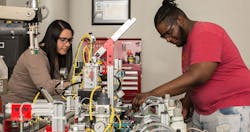Can an entire movement start with a letter?
Former IBM CEO Ginni Rometty believes so.
On Nov. 14, 2016, she sent a letter to then-President-elect Donald Trump about a new way to look at jobs. In it, she offered some key suggestions about how IBM could help the administration’s goal of “harnessing the creative talent of people for the benefit of all.”
One of her suggestions was to create “new collar” jobs.
“Getting a job at today’s IBM does not always require a college degree; at some of our centers in the United States, as many as one-third of employees have less than a four-year degree. What matters most is relevant skills, sometimes obtained through vocational training. In addition, we are creating and hiring to fill 'new collar' jobs—entirely new roles in areas such as cybersecurity, data science, artificial intelligence and cognitive business.”
Why the need to assign a name to this new type of job? Changing words can lead to a change in thinking. For these jobs, the “new” designation addresses the need for information technology skills, which are now part of all jobs in a manufacturing company, including those on the plant floor.
Rometty’s campaign for new collar workers is finding success, says Kelli Jordan, director, careers and skills at IBM. “This term is becoming recognized across the industry.”
The term came in response to an issue that IBM has been working to resolve since 2016.
“Thousands of jobs were going unfilled in our company, so we wanted to create new pathways and opportunities to find talent,” Jordan explained. “By looking at different options, we can find candidates, across all backgrounds and education levels, that we might not have considered before.”
The concept is to look at ability, not academic grooming. “We have a lot of jobs that don’t require degrees but require skills,” says Jordan. Each year, new collar workers account for about 15% of IBM’s U.S. hiring.
That strong pipeline at IBM stems in part from a system of P-Tech schools that it started in 2001 in Brooklyn, New York.
And this is the model Rometty offered to President Trump in that letter:
“You’ve spoken about the importance of vocational education, and we agree. IBM has championed a new educational model for the United States—six-year public high schools that combine traditional education with the best of community colleges, mentoring, and real-world job experience. The first of these schools opened with IBM’s support 5 years ago in New York.”
The company has been building on this concept and in 2017 launched the IBM Apprenticeship Program. Since launch, the program has grown twice as fast as the company had planned—by the end of 2019, IBM had hired upward of 450 apprentices. More than 90% of the apprenticeship graduates to date have been hired.
Already in 2020, the company has hired 100 additional apprentices and expects to hire thousands over the next several years.
The seed that was planted by IBM has taken root across the country, landing squarely at community college campuses.
One program at a community college is the Tri-C Manufacturing Technology Center, located in Cleveland. “While we don’t use the term ’new collar,’ we have embraced the concept in our workforce training programs,” says William Gary, executive vice president of Tri-C’s Workforce, Community and Economic Development division. “For many years we have worked closely with companies, and we heard their needs and adapted programs to address those needs, especially in advanced manufacturing.”
And it’s working. “We are closing the skills gap,” says Gary.
“Not many people talk about that,” Gary adds. “There is a lot more that needs to be done, but working in collaboration with a variety of stakeholders we are providing the training people require to meet the current needs of the businesses. Our program is an on-demand program.”
And this training (both technical and soft skills) is exactly what is needed to fill many of the middle-skill jobs that remain unfilled at manufacturing companies. “Employers often can’t wait for workers, or students, to get a two- or four-year degree, so these programs fill that gap,” says Gary. “And if the individual wants to continue to a two-year degree, our institution will provide credit for the training they have completed in this program.”
A Badge of Honor?
There is another program available to tackle this challenge as well—"new collar badges," which certify the training necessary for new collar workers. And this seems to be catching on, explains Sarah Boisvert, co-founder of Potomac Photonics, which commercialized laser micro machining products. She formed Fab Lab Hub in 2012 in association with MIT’s Center for Bits and Atoms. Her lab is part of an international Fab Lab network.
“Conditions today require new pathways and education models,” explains Boisvert. “As blue-collar jobs become digital new collar jobs, a four-year or even a two-year degree is not required, which opens up options for training programs.”
Boisvert came to this conclusion after interviewing 200 U.S. manufacturers on the skills needed in smart manufacturing and wrote the book, The New Collar Workforce in 2018.
This workforce needs to have the digital skills necessary to run automation and software, design in CAD, program sensors, maintain robots, repair 3D printers, and collect and analyze data.
“These are the skills that will make digital fabrication for Industry 4.0 possible,” says Boisvert.
North American Digital Fabrication Alliance member Fab Lab Hub developed the initial New Collar Workforce badges for additive manufacturing. More digital badges are on the way, according to the New Collar Network, including lab safety badges created by the Los Alamos National Lab and funded by the New Mexico Department of Economic Development, while Forest Scientific is collaborating on CNC machining badges. Other badges on the horizon address laser machining, welding, design thinking and entrepreneurship.
“These badges offer a wonderful opportunity for kids to find out what they like and what they don’t,” says Boisvert. “Some kids prefer to run machines, and this gives them pathways and careers. They can find engaging work that allows them to eventually support their families.”
The goal of this badge program is to be affordable both in terms of dollars and time, says Boisvert. And it is; on average it’s a six-week program and costs $250.
Boisvert is expanding her reach through a second book, People of the New Collar Workforce, which will be available in April 2020.
And she has created the New Collar Network, which is a group of educators, employers, concerned citizens, parents and policymakers who are looking to make a difference through new models of education and economic development.
Time for New Public Policies?
New models of viewing the American workforce is exactly the mission of Jane Oates, president of WorkingNation, which is a non-profit organization focused on workforce issues. Oates, who served as assistant secretary in the Employment and Training Administration under Labor Secretary Hilda L. Solis in the Obama administration, said that Rometty’s statement in 2016 was an important one to have made.
“People have been struggling since the recession to figure out new ways to find the skills and behaviors necessary for the new jobs that have been created by technology or that have changed due to automation,” Oates explains. “The terms blue- and white-collars jobs don’t make sense in today’s job market. They are outdated.”
Oates points out that the U.S. has used the bachelor’s degree as a de facto tool to measure someone’s ability to learn. “So, it was important for Ginny to say that we have other ways to measure the competencies that people have.”
While she believes that the message is clearer since the term “new collar” was invented, there is more that needs to be done. Current economic factors, however, are helping make the case for new collar workers due to the high cost of college degrees, which in turn has created a lot of debt. And college graduates are working at jobs that don’t require degrees.
Different forms of education can lead to rewarding jobs, Oates says. And manufacturing is one of the industries that address all of these issues. Many companies are offering apprenticeships and other training opportunities to bring new people into the field, which has greatly improved its image. “I salute the work of the National Association of Manufacturers for moving the perception of the industry from dark, dangerous and dirty to clean, high-tech and exciting,” she says.
Another welcome trend is the emergence of regional partnerships for apprentices and other training, says Oates. “We especially need to pay attention to small employers as they are adding jobs and are embedded in the communities. They will greatly benefit from these public-private partnerships.”
The best route for these partnerships is to work closely with companies to determine specific job needs. Community education should be aligned with the skills of open jobs. “When people go on their own to get these certifications, there isn’t always a job waiting at the end,” explains Oates.
How we view jobs and work must expand, she says. Oates would like to see new collar jobs advertised on places like LinkedIn. This would encourage people to think about what certifications they might need and how the certifications can be applied across industries.
The education system can play an important part in how new collar jobs are viewed, by having work-based learning in classrooms, Oates advises. Tying skills learned from grade school on up to specific jobs can help students make better decisions about a wider variety of career choices.
Combining educational institutions, companies and economic development agencies will result in a trifecta of workforce development.
IBM would agree. “We look for opportunities to share what we have learned about apprenticeships and employment models with companies and organizations,” Jordan says.
Widening this circle of influence even further, Oates says there needs to be a statewide or national policy that centers around lifelong learning.
That perspective embodies the new collar designation. And Rometty would certainly approve of that goal and feel more than proud that her letter created a workforce revolution.
About the Author
Adrienne Selko
Sr. Editor
Focus: Workforce, Talent
Email: [email protected]
Follow Me on Twitter: @ASelkoIW
Senior Editor Adrienne Selko has written about many topics over the 17 years she has been with the publication and currently focuses on workforce development strategies. She is also a senior editor at Material Handling & Logistics and EHS Today.
Previously Adrienne was in corporate communications at a medical manufacturing company as well as a large regional bank.
She is the author of Do I Have to Wear Garlic Around My Neck?, which made the Cleveland Plain Dealer's best sellers list.

